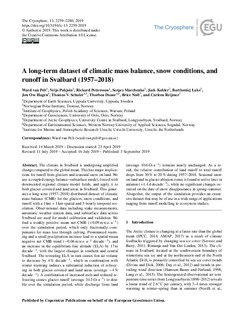| dc.contributor.author | Van Pelt, Ward | |
| dc.contributor.author | Pohjola, Veijo | |
| dc.contributor.author | Pettersson, Rickard | |
| dc.contributor.author | Marchenko, Sergey A. | |
| dc.contributor.author | Kohler, Jack | |
| dc.contributor.author | Luks, Bartlomiej | |
| dc.contributor.author | Hagen, Jon Ove Methlie | |
| dc.contributor.author | Schuler, Thomas | |
| dc.contributor.author | Dunse, Thorben | |
| dc.contributor.author | Noel, Brice | |
| dc.contributor.author | Reijmer, Carleen | |
| dc.coverage.spatial | Svalbard | nb_NO |
| dc.date.accessioned | 2020-01-31T13:22:52Z | |
| dc.date.available | 2020-01-31T13:22:52Z | |
| dc.date.created | 2020-01-09T15:40:00Z | |
| dc.date.issued | 2019 | |
| dc.identifier.citation | van Pelt, W., Pohjola, V., Pettersson, R., Marchenko, S., Kohler, J., Luks, B., . . . Reijmer, C. (2019). A long-term dataset of climatic mass balance, snow conditions, and runoff in Svalbard (1957–2018). The Cryosphere, 13(9), 2259-2280. | nb_NO |
| dc.identifier.issn | 1994-0416 | |
| dc.identifier.uri | http://hdl.handle.net/11250/2639091 | |
| dc.description.abstract | The climate in Svalbard is undergoing amplified change compared to the global mean. This has major implications for runoff from glaciers and seasonal snow on land. We use a coupled energy balance–subsurface model, forced with downscaled regional climate model fields, and apply it to both glacier-covered and land areas in Svalbard. This generates a long-term (1957–2018) distributed dataset of climatic mass balance (CMB) for the glaciers, snow conditions, and runoff with a 1 km×1 km spatial and 3-hourly temporal resolution. Observational data including stake measurements, automatic weather station data, and subsurface data across Svalbard are used for model calibration and validation. We find a weakly positive mean net CMB (+0.09 m w.e. a−1) over the simulation period, which only fractionally compensates for mass loss through calving. Pronounced warming and a small precipitation increase lead to a spatial-mean negative net CMB trend (−0.06 m w.e. a−1 decade−1), and an increase in the equilibrium line altitude (ELA) by 17 m decade−1, with the largest changes in southern and central Svalbard. The retreating ELA in turn causes firn air volume to decrease by 4 % decade−1, which in combination with winter warming induces a substantial reduction of refreezing in both glacier-covered and land areas (average −4 % decade−1). A combination of increased melt and reduced refreezing causes glacier runoff (average 34.3 Gt a−1) to double over the simulation period, while discharge from land (average 10.6 Gt a−1) remains nearly unchanged. As a result, the relative contribution of land runoff to total runoff drops from 30 % to 20 % during 1957–2018. Seasonal snow on land and in glacier ablation zones is found to arrive later in autumn (+1.4 d decade−1), while no significant changes occurred on the date of snow disappearance in spring–summer. Altogether, the output of the simulation provides an extensive dataset that may be of use in a wide range of applications ranging from runoff modelling to ecosystem studies. | nb_NO |
| dc.language.iso | eng | nb_NO |
| dc.publisher | Copernicus Publications | nb_NO |
| dc.rights | Navngivelse 4.0 Internasjonal | * |
| dc.rights.uri | http://creativecommons.org/licenses/by/4.0/deed.no | * |
| dc.title | A long-term dataset of climatic mass balance, snow conditions, and runoff in Svalbard (1957-2018) | nb_NO |
| dc.type | Journal article | nb_NO |
| dc.type | Peer reviewed | nb_NO |
| dc.description.version | publishedVersion | nb_NO |
| dc.rights.holder | © Author(s) 2019. | nb_NO |
| dc.source.pagenumber | 2259-2280 | nb_NO |
| dc.source.volume | 13 | nb_NO |
| dc.source.journal | The Cryosphere | nb_NO |
| dc.source.issue | 9 | nb_NO |
| dc.identifier.doi | 10.5194/tc-13-2259-2019 | |
| dc.identifier.cristin | 1769695 | |
| cristin.unitcode | 203,12,7,0 | |
| cristin.unitname | Institutt for miljø- og naturvitskap | |
| cristin.ispublished | true | |
| cristin.fulltext | original | |
| cristin.qualitycode | 2 | |

